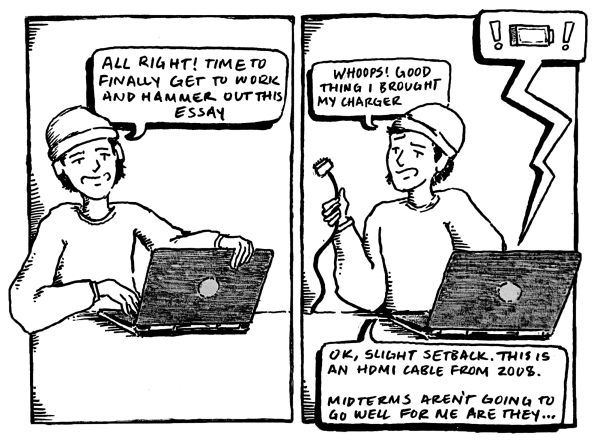Disabled Student-Athletes Must Have Accessibility Needs Met
In light of the Academic and Administrative Program Review and financial stress at Oberlin College, there has been a lot of student concern surrounding physical accessibility. We know that there will be absolutely necessary cuts in order to secure the financial longevity of the institution. However, one thing that cannot be sacrificed is accessibility for disabled students.
The resources for disabled students are already slim. Despite the genuine effort, care, and concern that Disability Resources staff provides, the department is drastically under-resourced. Some academic buildings and dormitories are not up to code, and others are entirely inaccessible to those with physical disabilities. Work orders are often not completed in a timely manner, which can be a serious threat to the well-being of all students, especially disabled students. Additionally, parking lots that are accessible to buildings — especially dorms — are almost completely nonexistent.
Because of the variety of these concerns, certain aspects of accessibility are often overlooked or ignored altogether. One group that often gets lost in this shuffle are disabled athletes. This not only includes varsity athletes but also club and intramural athletes, students who take athletic classes, and anyone who participates in athletics recreationally at Oberlin.
It is no secret that many current conceptions of disability and accessibility lack appropriate scope, nuance, and intersectionality. Many people — especially those not at Oberlin — have very specific pictures in mind when it comes to disabled people, most commonly involving some sort of visible physical impairment.
Sadly, these misconceptions are what keep some students, including disabled athletes, from receiving the accommodations they need to thrive on campus.
While many people at Oberlin do have a nuanced understanding of disability and accessibility, the vast majority of Americans have a very black-and-white view of the subjects. Many people do not believe that disabled people can be “real” athletes. Disabled bodies are commonly thought of as less than or unequal to abled bodies; this then feeds into the thought that disabled bodies simply cannot do the things — such as athletics — that abled bodies can.
When disabled athletes perform on the national stage — such as Shaquem Griffin, an NFL Seahawks linebacker with only one hand — it is thought to be a miracle or an enormous feat, despite the fact that there are plenty of highly successful disabled athletes. Because of this, not much thought goes into the accommodations and accessibility needs for disabled student-athletes which, unfortunately, can cause some disabled student-athletes to internalize the misconception that disabled people cannot be athletes.
After suffering from severe chronic back pain for eight years, I was finally diagnosed with ankylosing spondylitis, a degenerative arthritic condition affecting the spine. When I received the news, I was immediately concerned about my ability to continue playing collegiate soccer. I have been playing the sport since I was four and did not want to give it up.
Ultimately, my doctor gave me the OK to continue playing; however, I was told that I could not lift weights in the same way as I had been, and I had to remove myself from play if I began to have a flare-up. I continued to play with the knowledge that I am heavily susceptible to spinal fractures and spinal injuries.
While I acknowledged that my condition fit common definitions of disability, the fact that I continued to participate in athletics caused me to reject the idea that I was disabled. At the time, it did not matter that I frequently struggled to walk from my car to my dorm, or that I often woke up in the middle of the night due to pain.
It took me a while to accept that I am disabled and that I deserve accommodations regardless of my ability to participate in athletics. And while I acknowledge that there are times when lacking a visible disability gives me more control over how others perceive me, I still suffer from the condition that I have; I am justified in asking for accommodations that will make my life more manageable.
As it stands right now, however, student-athletes are not getting the accommodations they need. Both the administration and students have failed to recognize the ways that athletics programs and facilities are not accessible for students. This is unacceptable for a number of reasons. Firstly, the introduction of YeoFit — a health initiative recently implemented by the College — is aimed at getting all Oberlin students involved in athletics; however, disabled students are left out of this program because many of the classes offered through Yeofit do not consider the needs of students with physical limitations. Secondly, working out is often key for many disabled people’s mobility and overall health. For example, my arthritic conditions, including my own, require consistent, low impact activity in order to avoid stiffness and spinal immobility.
There are places in Philips gym that could certainly be more accessible. Currently, the weight room is highly inaccessible. It is often overcrowded — which can be intimidating for disabled athletes, especially ones that are not varsity athletes — and there is not much walking room. To solve this, priority hours for disabled students could be implemented.
There could also be athletic classes offered specifically for students with disabilities that not only accommodate their specific accessibility needs but aim to directly cater to them. Campus Dining Services should ensure that student-athletes with dietary restrictions related to disabilities have plenty of options to properly fuel their bodies.
There are plenty of accessibility concerns that must be addressed at Oberlin College. However, these things can only be addressed when students voice their dissatisfaction or concern. Developing a more comprehensive understanding of disability would not only help all student-athletes at Oberlin realize and ask for the accommodations they need, but also help ensure that Oberlin becomes adequately accessible for all disabled students.


